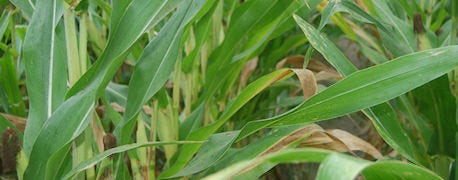
Scouting very severely impacted corn fields from drought and heat, Dave Nanda, a plant breeder and director of genetics and technology for Seed Consultants, Inc., noted that the firing going on from the bottom up was technically not just plants dying. It was plants showing signs of nitrogen deficiency.
In fields where he has seen an N deficiency, he knows N was applied, either all commercially as anhydrous, or through a combination of chicken litter, N as starter and sidedressing. The soil where the roots are operating is simply too dry for roots to effectively take N up into the plant and utilize it, he says.

N deficiency- Note the signs of N deficiency in these drought-stressed plants.
That's not to say there isn't N in the plants. Anyone chopping drought-stressed corn will want to test nitrate levels to make sure they don't make a product so high in nitrates that it is toxic to livestock, particularly cattle. Nitrates at high levels can be lethal to cows.
The classic N deficiency symptoms include yellowing starting at the tip and working down the midrib. As it becomes more severe, leaf tissue turns brown and dies. Nanda has found symptoms on leaves well above the ear leaf.
In this case, the correct way to say it is" above the ear leaf position." In many of these fields, there are no ears. It was so hot and dry at pollination that tassels emerged and dispensed pollen, but shoots and silks weren't out to receive it. Some plants sent out shoots later. Some never did.
In a normal year, N deficiency above the ear leaf at this stage in the game would be cause for alarm and a sharp signal to evaluate your N program. This year it's just another symptom in a long list of symptoms that have devastated the crop. It wasn't the N delivery system that went haywire, but the environment instead.
About the Author(s)
You May Also Like




